Paul’s Plane Strategy
“Lay the plane on its side, lad,” he said, the teacher.
“Yes, sir!” the boy replied. And he lay the plane down on its side unquestioningly.
I thought even then, aged 13, that it seemed a funny thing to do. I asked the teacher, “Sir, why do we lay it on its side?
“It protects the blade. Keeps it safe.” The teacher said, in a way that made me feel stupid for asking the obvious.
I waited a minute, not seeing the obvious, and then said, “How does it do that, sir?”
The teacher stared at me as if searching my mind for an answer. “Isn’t it obvious, boy? Think about it.”
So I thought and I thought but nothing seemed obvious to my 13-year-old mind at all. I said, “I can’t think of anything that protects the plane any differently than standing it up, sir!”
“Don’t be impertinent, Sellers!” came back the reply. “Just do as you are told!”
And so it was for decades before that, even on a global level, woodworkers at an amateur level and a professional one unquestioningly laid and lay their planes on their sides with no good reason beyond, “Because I said!”. Then, when I laid my plane on its side as an apprentice for the first time of using it, George said to me, “What are you doing? and I never did it again. It was just plane silly.
And so it can be with tradition. But we all start out that way and we have all been influenced by woodwork teachers in schools to lay our planes on their sides to protect the cutting iron when in reality it is a ritualistic procedure that has nothing to do with the protection of the plane iron in our day to day. I have had woodworkers agree with me that it indeed makes no sense even to them but that they will continue to do so regardless. This, to me, is weird. Not only is it a weirdly strange thing to do, but it’s also just about the most inconveniently awkward thing in the world of working wood to do too. My planes come into play minute by minute. I switch between a heavy-cut, converted #78 scrub plane to a medium-cut #4 smoother converted to a scrub plane, a #4 1/2 jack plane, a #4 jack plane and a #4 smoothing plane all the day long. Imagine all those planes lounging around on their sides on my benchtop as I plane up my rough-sawn cherry and oak to superior levels of conditioning to make my furniture. Such is the way that I work today. It can confuse my audience but by doing what I do I am training them to not give in to the status quo set by school teachers preventing 13-year-old boys from plonking their planes down on other metal tools back in the 1930s. We who are at our own benches in our own shops with our own tools know exactly how and where we place our planes to work with them. My system for truing up wood is the best system for hand toolists to adopt bar none. It’s not anything more than a practical solution to working efficiently and effectively without relying on machinery to get me where I need to be. Following is the system I use on every single stick and stem of wood that comes into my workshop and then into my videos as I teach and work.
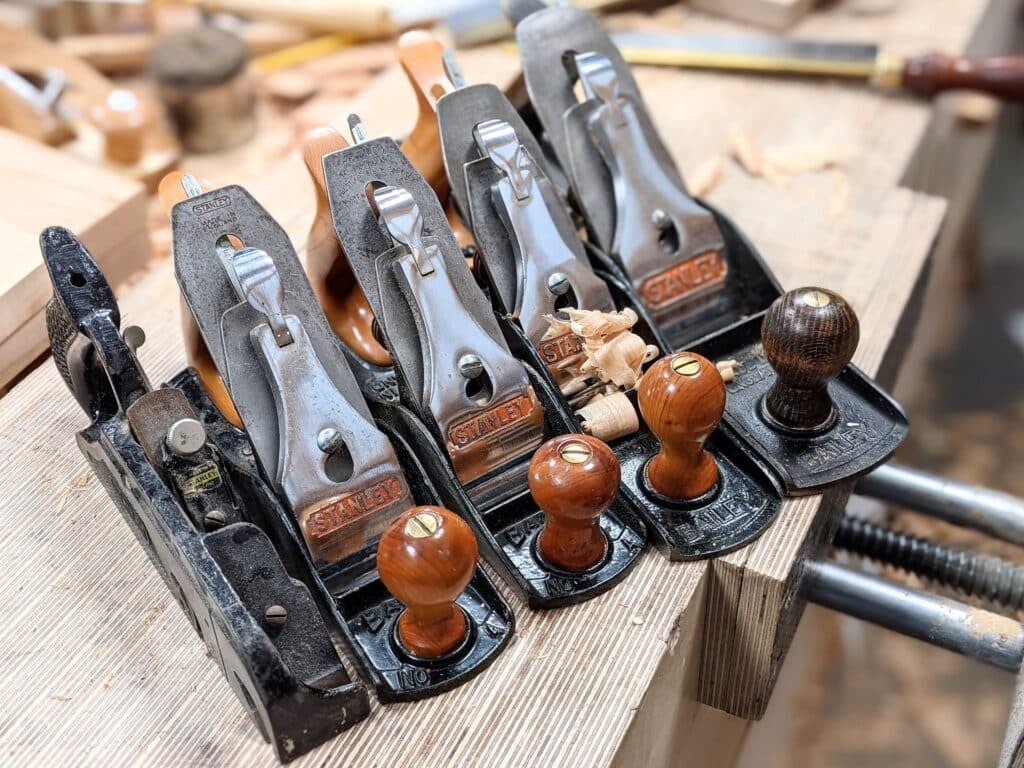
The board comes into my work area and I usually cut it to length, adding an inch to allow for trimming and squaring; less if things are a little tight. I true up one edge but don’t spend too much time on it just yet as I will work everything down further as `I progress. I will most likely use my #4 converted into a scrub plane for this edge-jointing but remember I am not fully truing just yet. With this edge fairly close I then rip the piece to close width so that truing up the wider flat face requires no excess of energy. Back to the vise or the benchtop, I use one of my two scrub planes to remove the surface fibres down to solid wood. My choice of plane depends on the condition of my wood. Heavy undulation from bandsaw cutting, twist, cup and bow, determine that I reach for my heavy-scrub plane which is my converted #78. This tool works so amazingly well for this element of truing and no other plane comes close. I may not have invented the scrub plane, I did invent the conversion of the #78 into a scrub as a strategy as key to the most efficient removal of flawed wood to lower the resistance for my other planing refinement.
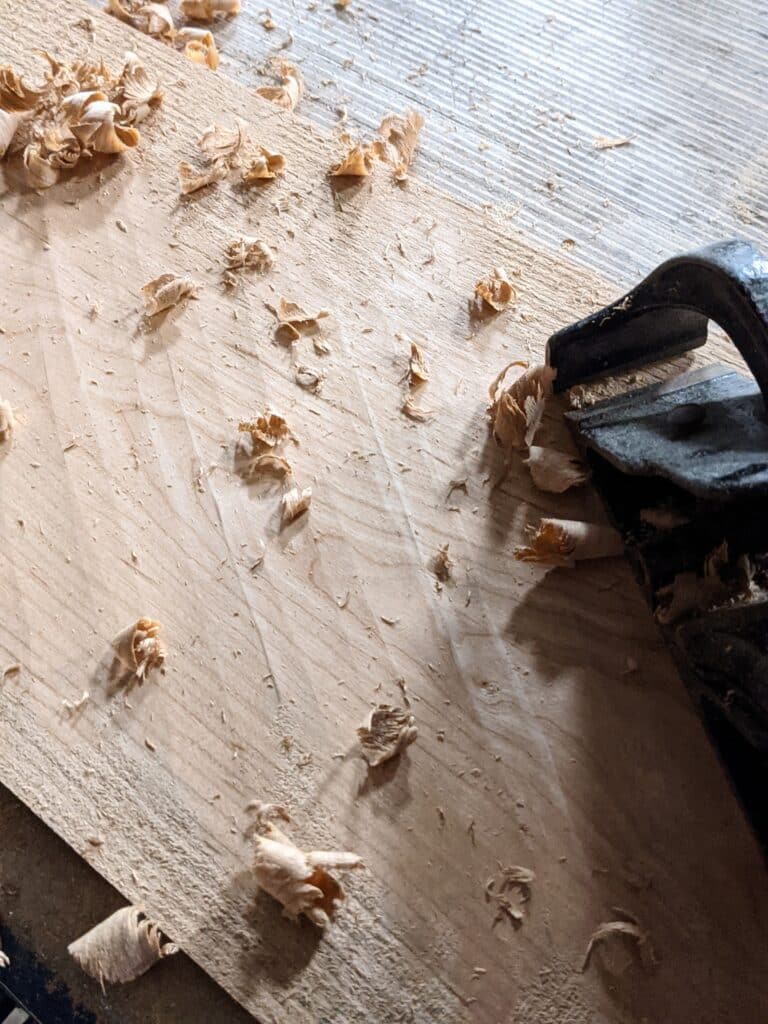
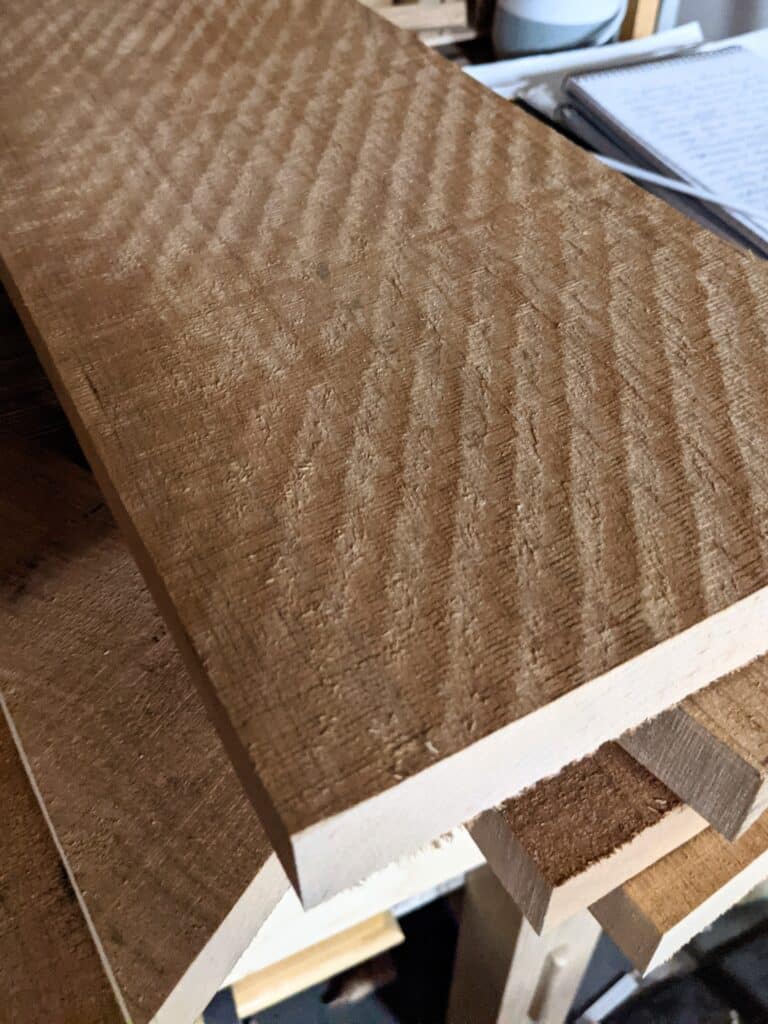
My next plane is my lesser scrub, the Stanley #4. By now you will see that I am not in any way a proponent of minimalism in hand tools. That’s plane silliness, but sometimes acceptably necessary by those with limited space and limited finances starting out. Little more than that. This plane has a shallower sweep to the cutting edge of the cutting iron and takes off the more regular highs left by the #78. Keep it good and sharp by learning the figure-of-eight method of sharpening curved cutting irons and gouges. If you ever want a vintage look to your tabletops, this plane can be used to that end. As the #78 has removed 95% of the serious faults like twist, cup and bow, and, indeed, I used winding sticks even at that coarser level to get closer, the #4 refines this all the further to get as close as possible to a trued-up first face.
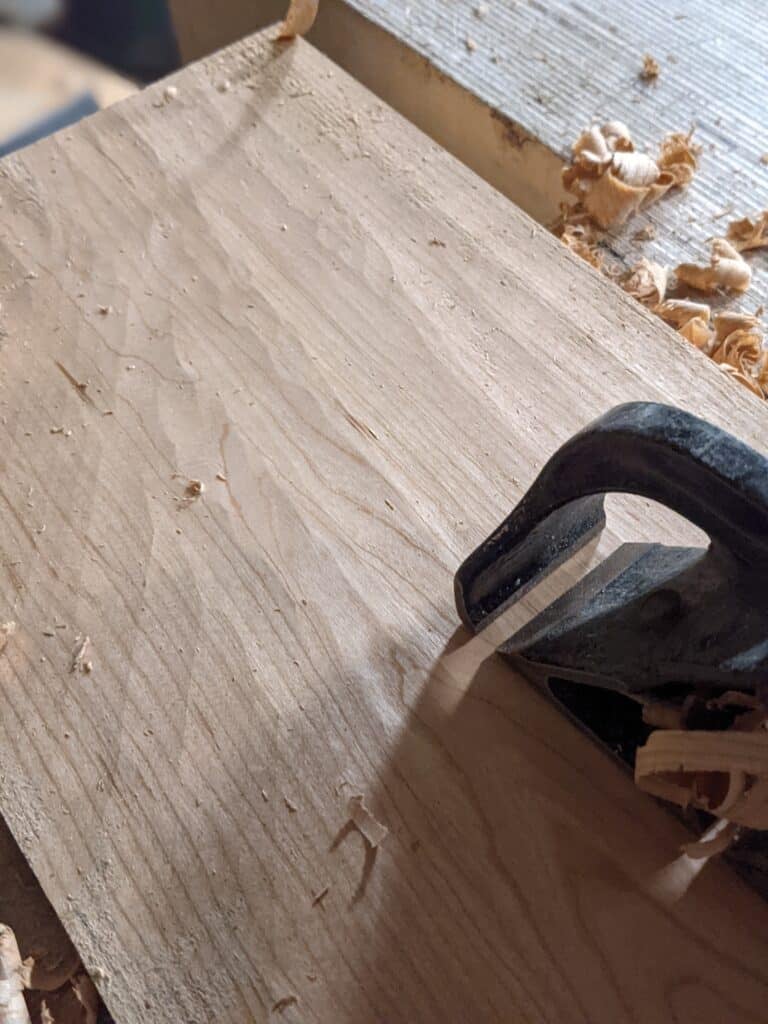
My next plane choice is a matter of preference but usually, I will reach for a #5 1/2 because that extra 3/8″ width in the cutting iron gives me that added truing capacity `I like in terms of width. The downside, of course, is the extra weight, surface friction and energy the extra width requires to motor through with the planing strokes. Initially, of course, it takes only minimal effort because the scrub planes leave an undulated surface and the wide and long plane rides the highs at first and the strokes are indeed ever-widening as the peaks are lowered down to the lowest of the valleys. I will switch then to the #5 on a fine setting to true up further after my #5 1/2 and of course, through every planing level I rely constantly on my winding sticks to make any corrective swipes to maintain striving for perfection.
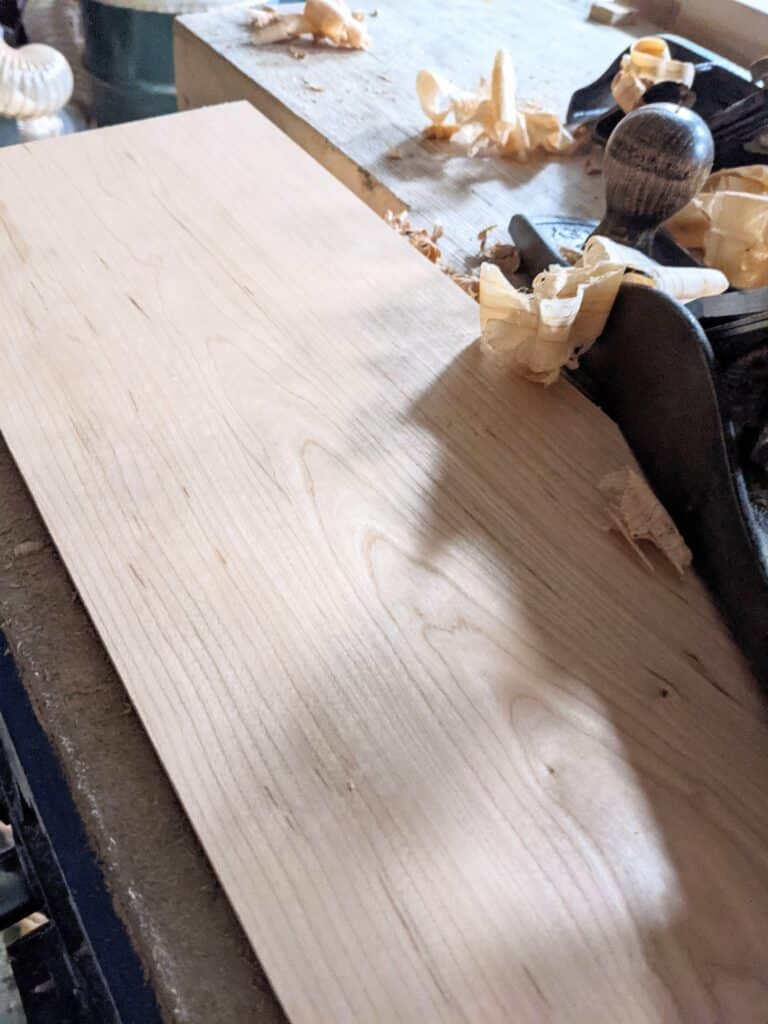
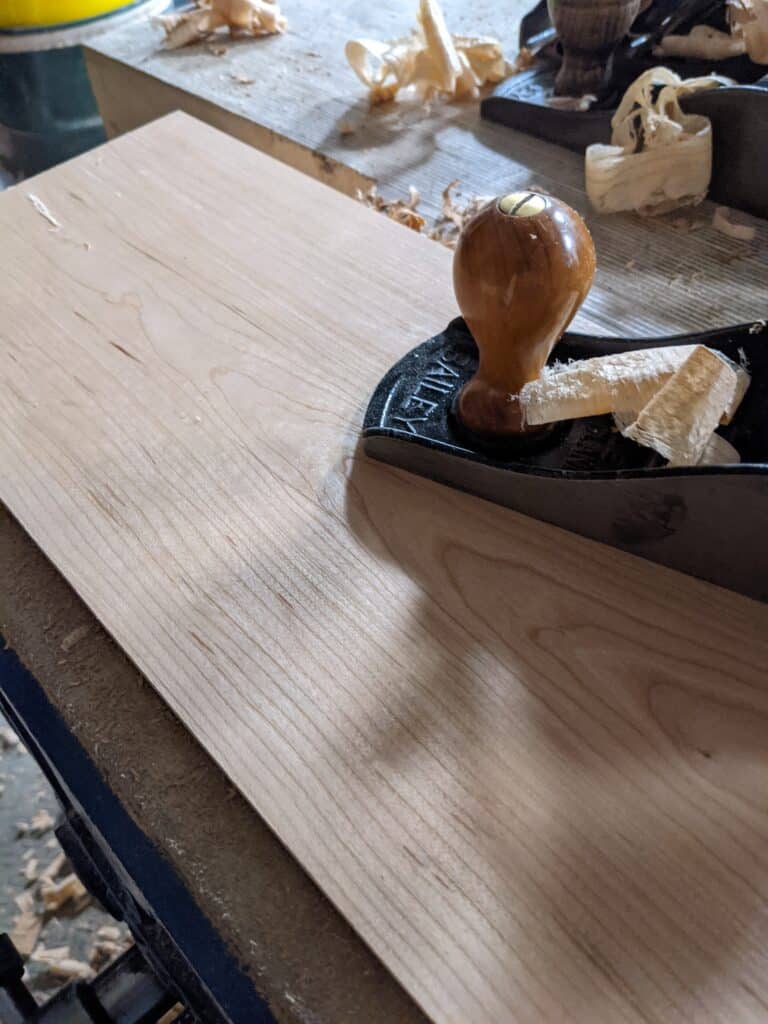
By this point my wood feels glass smooth. Still, I am not quite done. I now use my smoothing plane for what it does exceptionally well which is, well, smoothing. This little Arabian stallion of planes twists and turns to engage any and all difficult grain changes of direction. I can spin it on its axis to keep always with the grain and after this, my first face is totally trued to dead flat.
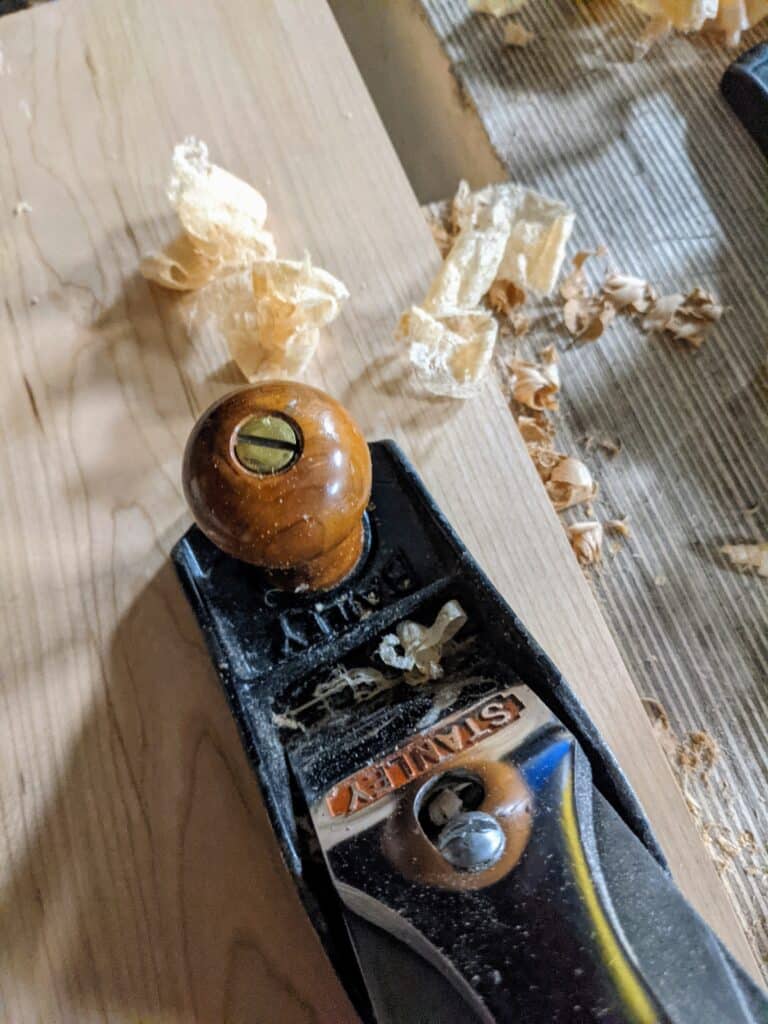
. . . it’s my #4 that gives me the finest refinement of surface of all. I keep this plane immaculately sharp all the time so that there is no conflict on the finished surfaces.
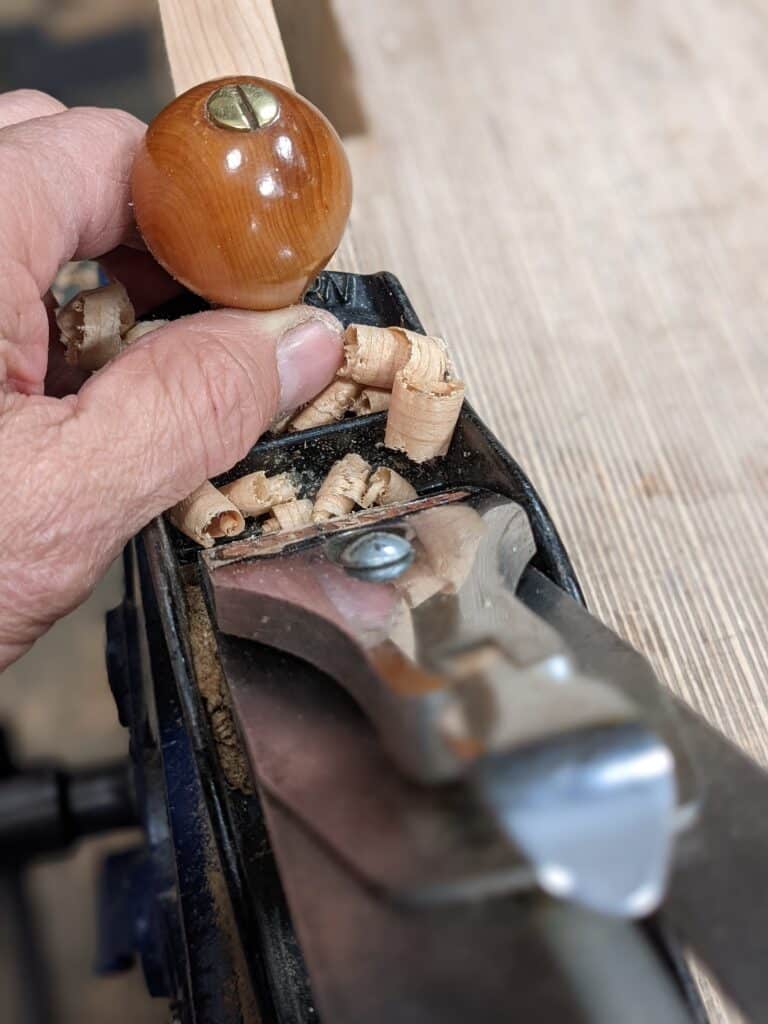
At this point, I will revert back to the first edge that I rough-trued with the #4 scrub plane and true it with a jack plane. Either one of the two will work fine. I could also use the #4 smoothing plane but the longer plane is helpful for straightening humps and hollows. Usually, I will go for the wider plane. The extra width gives me the same advantage as the tightrope walker with the long pole helping to balance. It’s marginal but it is there. I use the square, registered against the first face, to check for squareness and sight along the corner for straightness.
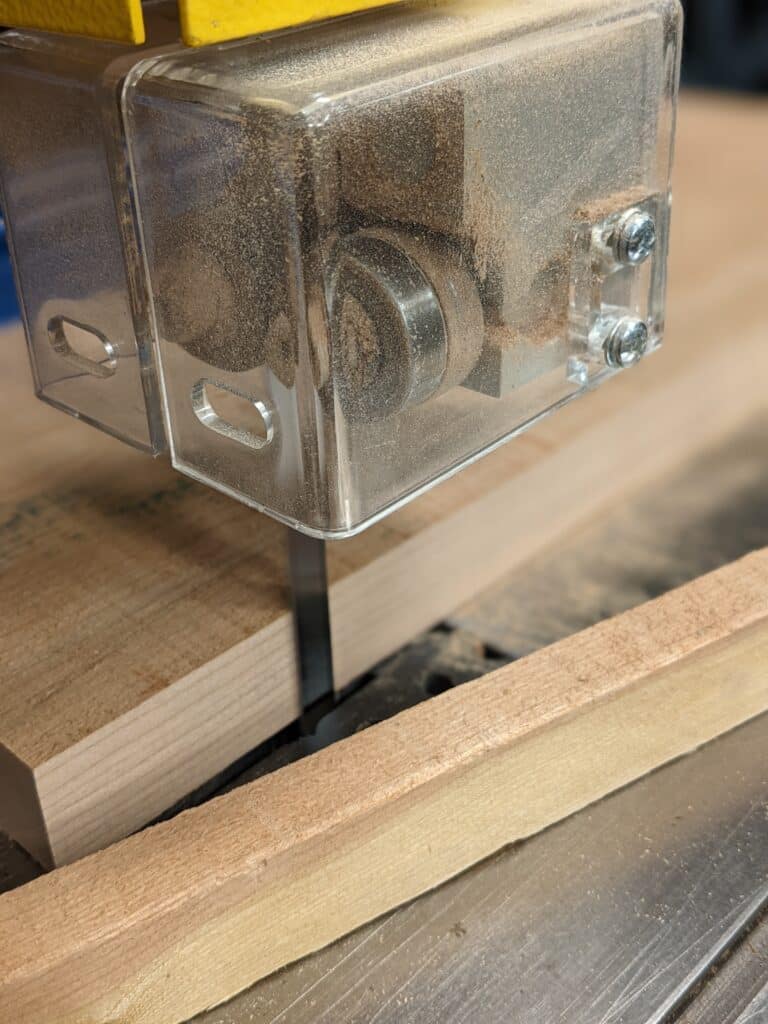
With these two faces straight and true, I rip to width following either a gauge line if using a handsaw or the fence if using the bandsaw. I leave on a mere 1/32″ (1mm) to plane down to parallel smoothness, which takes but a few strokes no matter the wood type. I may or may not need the #4 scrub plane first depending on the level of cut I get from the sawing. With a light setting on the cutting depth, the band width may be as little as 3/4″ so it takes down both handsaw and bandsaw marks rapidly. I reach for my # 4 1/2 to swipe stripes across the width and edge and then my #5 followed by my #4.

The contrast between my scrub plane irons is quite extreme as you can see here.
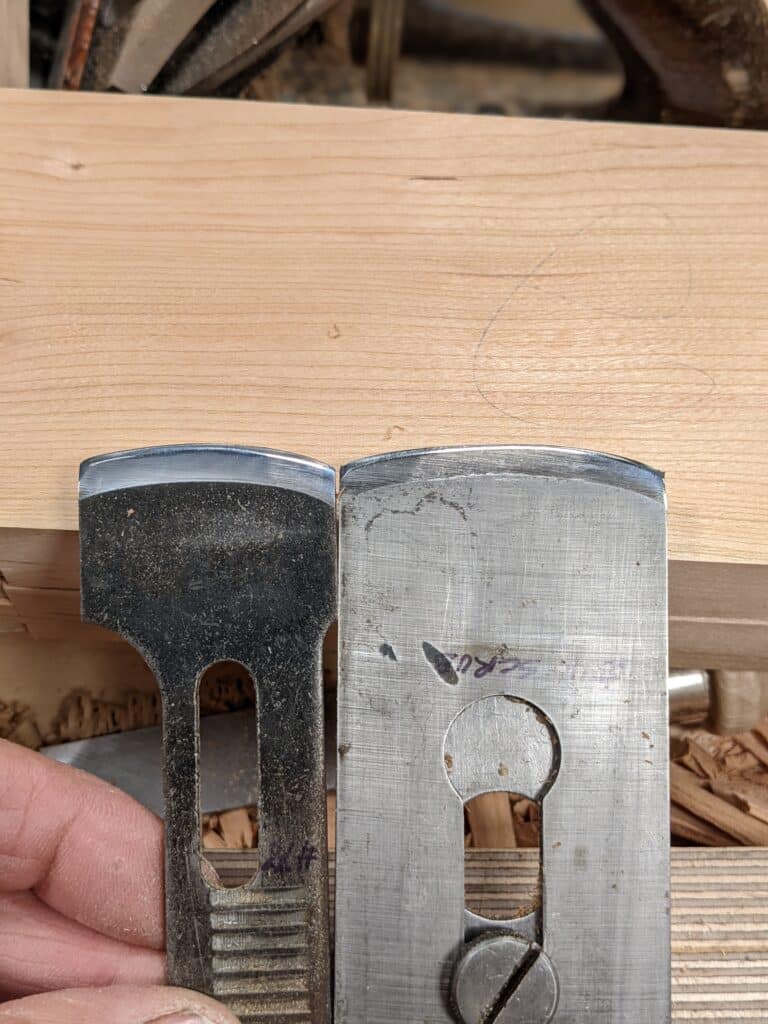
You might now see how silly it is to lay a plane on its side when the interplay in real life as a maker means the most efficient placement of the planes to switch from one to another throughout a process like this. My planes must be ready for action as must any woodworker who is time-strapped.


Hi Paul – thanks for another enlightening post. Could you perhaps explain the utility of using a no78 as a scrub plane over your converted no4?
Just deeper cuts that are amazingly fast. I own two manufactured scrub planes and the converted #78 works as well and better than these for a fraction of the cost.
Hi Paul,
Do you have any more details on how you converted the #78 to a scrub? By the way I live close to Willow City Loop. Drove past it this week.
I am so jealous. One night I drove the loop and counted 138 Whitetail. Nothing to convert on the 78 except a radius to the cutting iron.
Dan, if you google for “paul sellers 78 scrub plane” there is a blog post and a video on the whole procedure.
Hello Paul, what radii do you recommend for the various scrub plane cambers?
Radii really do not matter. Back in the olden days, carpenter did not care about all the nit picky details and actually got on with their work.
Your mentioned Back in the Olden Days reminded me of a reason some Craftsman sent their planes on the side. Used to be carpenters did much more fitting up work and out on a jobsite you may not find a nice wood surface to set your plane on it’s sole. Hence the set them on the side.
Just an old man musing
I have mentioned this several time in my blogs. Out on the job site, on a gravel pathway, etc, of course, the plane goes on its side every time. Good reminder that not all things are black and white and for me to say people can do what they like but when it makes good sense it makes the reason for laying it on its side.
I’ll get back to you. It’s good to have both radii and yes, it does matter to have a couple to swipe away with as one will take off more and the other will act as a go-between between heavier curve and then the smoother, ect.
Simply PERFECT!
I’ve never loved my #78, but I’ve only used it for edges. Time for a change.
THANKS!
Hi Paul,
I set my plane right side up. Have I ever set the plane on another metal object and nicked it? Yes, and it taught me to be more careful. I find laying a plane on its side so awkward and inconvenient that in practice it is a ridiculous notion.
BUT…. I attribute “Lay the plane on its side” to sharpener’s prerogative. In a school setting where the instructor does the sharpening some students will lay the plane on another tool and nick the iron. In my school’s wood shop most of us were there because wood shop sounded easier than our alternatives. A few did want to learn woodworking. I would expect a high school instructor to tell students “on its side” unless the students did their own sharpening. That has negative implications, but when I read about the problems introducing safer saws in American schools due to students taking the “Saw Stop Challenge”, can you expect respect for a plane iron?
Hello Paul,
I have always used a 4 1/2 and a 5 1/2 as my main bench planes, with a long wooden jointer and a wooden block scrub plane. Despite this, I have acquired a few No. 4s and 5s which are not currently in use. I would like to have an arsenal such as yours with a dedicated scrub and smoothing plane and such. Do you recommend either a 4 or 4 1/2 as a scrub or smoother? I have usually progressed from the scrub to the 5 1/2 to the 4 1/2, would having more planes at the bench be an advantage? I don’t currently own a spare 78
I’m not sure what Paul’s take on this would be, but I’d say that if you have already are using a scrub, #5 1/2 and #4 1/2, then you don’t actually NEED any more planes in your toolkit (for general dimensioning and smoothing). You could consider setting one of your #4 planes up as an intermediate scrub, like Paul does, and see if that streamlines your dimensioning process.
The more planes you add, the more distractions from woodwork you have – and you have to sharpen and maintain them. If your current setup is working for you, why over-complicate things? The point of woodworking is to make things with wood, not to acquire every tool in the world? 🙂
I also still find myself setting the plane down on its side. High school woodshop training I’m sure. 75 years old and old habits are still hard to break. Fortunately, I’m not working against the clock.
Hi Paul – thanks for the article.
How do you feel about a number 3 as a scrub?
I have a Faithfull No. 3 (good materials, poor construction, so lots of fettling needed) which I could convert. Narrower/lighter than a 4, so may be good?
Usually, I would say keep the #3 but with it being a Faithful brand I would go ahead and use it.
I like your precise wording of plain and plane – nonsense.
I once wiped chips off my work surface and my hand hit the sole of the plane. After first aid, it was time to rethink my habits. I can resharpen a blade easly if that is the issue. I can’t remember ever damaging an edge from another tool (I probably have). My only concern, especially if working too quickly is knocking my plane on to the floor. That happened when I was young with my beautiful Craftsman #4. It cracked almost in half. Now it is a corner plane. Sadly
Hi Roger, To me, your mishap requiring first aid is reason enough to lay the plane on its sole.
I do not place my planes on their side at the workbench. But I do when I use it in a rough and dirty environment, maybe like a carpenter for trimming a door. I think that’s where the habit comes from.
I lay planes on their sides. I don’t care whether it helps them or not. It makes me feel good laying them on their sides. I’m the guy that has to sharpen them after all.
I am sorry but laying the planes on their sides takes no less time than if you stand them up. So, any new woodworkers out there, laying the plane on its side is an impractical practice. Jus’ sayin’.
Hi I was taught at school to lay the Plane on its side in the well of the bench. I’m 67 now and still do it out of habit but always wondered why you would need to in a woodshop on a proper bench . After reading your blogs I now always think before laying the plane down but I will always lay it on it’s side in a dirty environment.
I entirely agree.
“Oh look, he lays his plane on its side. Now that’s a real woodworking craftsman!”
If I had five planes in constant use I might not. Not everyone is so well placed.
Not well placed at all, worked for and well earned. I think all of the full-time hand tool woodworkers I worked with had used several planes in quick succession because of the time it saved in working. It was always a small investment in terms of efficiency. Even then, it cost me a week’s wage to buy a plane.
I was told to leave my planes on there sides just in case there was some metal object near. But i have gone away from that idea and now i lean mine at angle in the well of my bench which i find comfortable to pick up. I learnt a lot of my woodworking from a Joiner in the village were i was born he kept all his planes on the end of his bench resting on a batten so he just had to pick them up and use them as they were all set and sharp . I would like to say thank you Paul for getting me back to hand work . When i first started i was ten and all my woodwork was by hand since i have work in commercial workshops and got used to machines but now there is so much satisfaction working with hand tools again.
Our woodwork teacher caned boys for putting a plane down sole down! I did it once. I’m now in my early 60s and took up woodworking 2 years ago and I put my plane down however I want to! With impunity!
I have a silly habit of setting them on piles of shavings as if they’re my beloved little pets in need of bedding. 🙂
It’s always good to question authority, Mike, and by that, I mean what was the root of the authority that told adult woodworkers today to unquestioningly lay their planes in a position of awkwardness on their sides and on their personal workbenches and in such away that the cutting iron can be damaged by the other tools that they use alongside them?
I built a Dutch tool chest and keep my most-used tools in the top section. It stays right behind me in my tiny shop (43 inches between the front bumper of my truck and the east wall of my garage) and when I put a tool down, I make a half-turn to the chest. Since my workbench is just under than 60 inches long, I’m willing to waste the time required for that half-turn. Confession: the bench planes rest iron-down in fitted cubbies on a thin piece of cork, while the block plane slips into a leather holster on the inner wall.
Dave, appreciate your comment as I am making a tool chest and decided just yesterday to cork the surface where my planes will lie blade down once the time comes……..thanks again for reinforcing my decision.
You do know that cork, leather, etc can hold moisture and cause rust if the tools are not in constant use though, don’t you?
Yes. My mitigation strategy is to oil the soles with a rag-in-a-can, which I learned from a well-known woodworking teacher. 😉
Why convert #4 and #78 to scrub planes when perfectly good, and I suspect superior in function ACTUAL #40 and #40-1/2 scrub planes are quite reasonably priced.
In the US, possibly, but then there is the rest of the world. Only one came up on eBay UK and that one was £325. A 78 and a lower quality Stanley #4 can be had for £15-20.
laying it on its side is also dangerous because you could swipe your hand on the blade, it’s actually less safe than laying flat on the bench.
I normally set my planes flat on the bench. Today, for some unknown reason, I laid a jack on its side and managed to trim the tip of my index finger when I reached to pick it up. No one’s fault but my own. So, flat is safer, at least when I’m being clumsy.
My woodwork teacher at school, Mr Pook, would have a fit. The plane must be put on the bench on its side he said. After Paul’s guidance my planes generally go sole down, except when Mr Pook’s ghost nudges me and I find a plane on its side.
There may be some logic for tradesmen working on site where there may not be nice clean wooden benches and the iron may be damaged with plane sole down.
It’s fun following this woodworkers controversy! I’m a retired woodshop teacher (’77-’08) and in my junior high school shop classes always told my students “a good plane always lands on its side” and they all followed suit. Why????, probably because that’s what I was taught and in truth, it did save cutting up on the bench and make my work sharpening 25-30 blades a bit easier. In my own work I still always land on it’s side; a habit I’ve had for over 50 years. Kind of like that old adage, ask 10 woodworkers the same exact question and you’ll get 12 different answers!
Yes, but read back in my blogs and you’ll find that the pattern was established around 1932 for schoolboys in woodshop who were plonking their planes on top of other metal tools and damaging the cutting irons. But why oh why do grown-ups perpetuate the ritual on their own benches in their own shops. For 56 years to date, I have never damaged a plane iron by placing the plane upright and IT DOES NOT DULL THE BLADE,
I’ve been using two planes thus far in my brief woodworking journey, a no4 scrub and a no5 “truer” / smoother (the latter step by taking lighter cuts). Eventually I’d like to get a no5-1/2 for the extra truing width and a no3 for smoothing, but for now can only get one more. Which would be a better buy from a productivity standpoint?
I don’t altogether get the missed step of the number 4. It’s not too wide, as the 5 1/2 can be and it’s much more versatile than the number 5 which can be too long for using as you say as a “smoother”. Localised plane work is so much better with a 4. The three is nice to have but scarcely used but some people do like them for smaller work, smaller stature and smaller hands
Perhaps I’ll head the no4 route after all, then. My thinking was that the narrower width of the no3 would be more advantageous for places where the grain has changed direction across the width of a smallish board. But (my limited) experience bears out what you’ve said about the limitations of using the no5 as a “smoother” as well — and the gains in time from smoothing with a no4 likely outweigh the less common scenario(s) where a no3 might have a slight advantage.
Thanks very much for your time.
I have both a 40-1/2 and #3 that I use as scrub planes. The #3 has the mouth opened and the blade radiused/cambered. The 40-1/2 is lighter, but the mouth is much wider. The space around the #3’s tote is a bit small, even for my smaller hands, but I prefer it. It seems to tear out less, even going across the width. If you have a spare #3, it’s worth trying it. I find the #78 quite hard to hold without a knob at the front, and it is inclined to clog up.
Hiya Paul. Maybe I am a bit strange but I keep a short piece ( 3or 4 inches ) of 2″x1″
on my bench and rest the toe of my planes on that. It keeps them upright and protects the edge as well as preventing accidental contacts.
Yours,
Mad Mick.
Don’t lay them on the side, that seems like too much effort, but I do set them with the heel on a small piece of scrap to raise the back up about 3/8″. Not to protect the blade, but to allow airflow and help combat rust. If setting it down for more than a few minutes (i.e. I’m done with it for a bit) they also get a quick wipe with the oil rag.
I found that even with oiling after use if I don’t allow airflow on the sole I will start getting rust. I doubt it makes any real difference for just setting it down for 15 min or so while I use another one, but more a matter of keeping the habit so I never need to think about.
Non-climate control in Houston, TX and this system grew out of trial and error fighting rust while not getting in my way.
Beyond the inefficiency of laying a plane on its side, practicality from a safety standpoint is enough for me not to do so.
Frankly I’d rather damage the plane’s cutting edge than damage to my flesh.
Thanks again Mr sellers for everything you do.
You have given me a love of using hands tools and the more i use them the more i seem to be connecting with them and enjoying more.
I love reading your stories of your apprenticeship and words of wisdom and how working with wood and hand tools makes you feel and what it gives you, have you ever thought of writing a book with them all in. i’m sure it would be a bestseller
Many thanks
Sean
Hi Paul,
A friend of mine took woodshop a few *ahem* decades ago and got yelled at by the instructor for leaving the plane upright on the bench. He pointed out to the instructor that when the planes were put away that they rested on a wooden shelf. On their soles.
The next day he found the instructor had tacked a wood strip on the back of the shelf that would hold the heel of the plane up so the iron wouldn’t touch! I guess there wasn’t much thought given to the part that the planes had sat on the shelf for at least 16 hours a day for years without coming to ruin.
I know I still flip a plane on the side just from force of habit. It’s hard to change.
-Tom Stenzel
I love this debate on laying on its side or upright, me I decided that the blade will come to no harm on my bench when I place it down. After all I am not lobbing across to land hard anyway. This made me think back to a MT podcast. A young woman cut the ends off the ham before placing in the oven. when asked why? “Because that’s what mom did. Her mother was asked the same and she said “because that’s what mom did”. The Grand Mother Said that what my mother always did. So they get to the Great Grand Mother to ask her why she cut the ends off the ham? She says because it was too big to fit in the oven.
I have a question about sharpening the plough plane irons of my traditional wooden screw-arm plough. The angles to sharpen them are are always 25 degree bevel on coarse grit and refined with a 30 bevel, as for the metal body ploughs like the Record?
(I looked to ask the question in a blog post specifically about ploughs, but found he comment section closed).
a #4 1/2 jack plane, a #4 jack plane
maybe
a #5 1/2 jack plane, a #5 jack plane?
I have a small collection of planes that are constantly in use or are being sharpened and oiled/waxed just for the fun of it. I have ten grandkids that are asking for new toys or new dressers…we don’t buy crap! I have enjoyed this blog immensely but the idea of wreaking blades and cutting hands and everything else due to laying planes on their sides or not is really tiresome. Buy a cheap piece of carpet or a roll of toolbox liner and stand your plane up. Problem solved. Now let’s get back to working with wood.